Chinese Healing Exercises (4 page)
Read Chinese Healing Exercises Online
Authors: Steven Cardoza
Tags: #Taiji, #Qi Gong, #Daoist yoga, #Chinese Healing, #Health, #medicine, #remedy, #energy

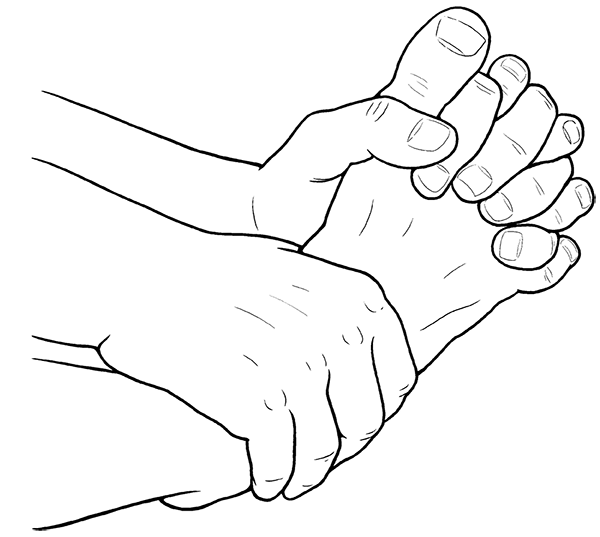 Figure 1.4 (Rotational Toe Stretch)
Figure 1.4 (Rotational Toe Stretch)
Your right hand holds your foot immobile, so that from your mid foot up to your ankle and lower leg, nothing moves. The palm of your left hand maintains contact with the sole of your foot as much as possible, to stimulate the Bubbling Well point. With your left hand, gently pull all of your toes straight out from your foot to create the traction used in Exercises 2 and 3. The traction is useful and beneficial, but secondary to what comes next, so if you lose it, don't be too concerned. Do your best to maintain that traction, and rotate your toes in clockwise circles at least ten times. Then reverse direction, rotating your toes in counterclockwise circles.
Do not remove your fingers at the end of this exercise. The next exercise begins in the same position.
Additional Considerations: Modifying This Exercise
Exercises 2 and 3 served to open your toes to facilitate interlocking your fingers between them. You may find that your toes are still too tight to allow such a full interlocking, and if so, you can modify the exercise in this way. You may only be able to get the tips of your fingers between your toes
(
Fig 1.5
)
,
or you may be able to get the first or even the second finger joint part way between your toes. However far you can get your fingers, that's okay for now. With practice and time, your feet will open more. Make whatever accommodations you may need to approximate the rest of the instructions until you can fully interlock your fingers and toes.
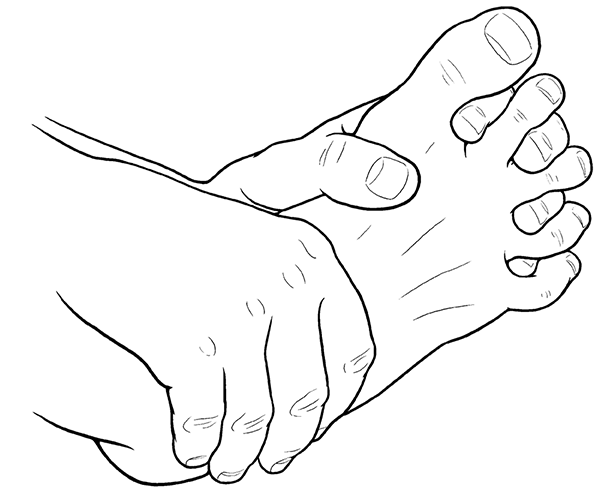 Figure 1.5 (Rotational Toe Stretch)
Figure 1.5 (Rotational Toe Stretch)
5. Rotational Foot and Ankle Stretch
Purposes and Techniques
These are the same as for Exercise 4, with these additions. Physically, it strongly stretches the muscles, tendons, and ligaments of the ankle; opens the ankle joint space. Mobilizes the metatarsal bones and opens the associated joint spaces. Energetically, it strongly stimulates most of the Shu Stream points of the foot, mostly found at various places along the general circumference of the foot up from the web of the toes, toward the ankle. Stream points are most commonly used to treat Bi (pronounced “be”) Syndromes, more colloquially called Painful Obstruction Syndromes, and which are often the same as or associated with various types of arthritis pain. This is especially true if Damp is part of the pathogenic picture, which is almost always the case in Bi Syndromes. That Damp may or may not visibly manifest as swelling or edema. (Damp, along with Dryness, Wind, Cold, and Heat, are both external, environmental, pathogenic influences and internally generated ones when organ systems are not functioning properly.) The reader who may be unfamiliar yet interested in this and other Chinese medical terms used in this book is directed to
The Web That Has No Weaver
by Ted Kaptchuk, for further insight. While such insight is useful and encouraged, it is not necessary in order for you to get the most from the exercises taught here.) The Kidney Shu Stream point, Kidney 3, is located just behind the inner ankle. Because of its association with bones and hence joints, that's a particularly important point used to treat most Bi Syndromes. This exercise also provides moderate to strong stimulation to the foot Jing River points, which are located at various points around and above the ankle.
Method
Beginning where you left off in Exercises 4, grasp your lower left leg with your right hand, just above your ankle. Your right hand holds your leg immobile, so that above your ankle, nothing moves.
Keep the palm of your left hand at the sole of your right foot with your left fingers interlocked between your right toes. Ideally, the web of your fingers should touch the web of your toes.
The palm of your left hand maintains contact with the sole of your foot as much as possible, to stimulate the Bubbling Well point. With your left hand, gently pull all of your toes straight out from your foot to create the traction used in Exercises 2, 3, and 4. As in Exercise 4, the traction is useful and beneficial, but secondary to what comes next, so if you lose it, don't be too concerned. Do your best to maintain that traction, and rotate your entire foot from your ankle in clockwise circles at least ten times
(
Fig 1.6A
and
Fig 1.6B
on next page
).
Then reverse direction, rotating your foot and ankle in counterclockwise circles an equal number of times. When you finish, hold your foot still, slightly grip your
toes with your interlocked fingers, and pull your fingers straight out beyond the tips of your
toes. This gives your toes one last stretch, and may spread them just slightly farther than previously. If you have dislodged any stagnant qi, this pull will help remove it from your foot and toes.
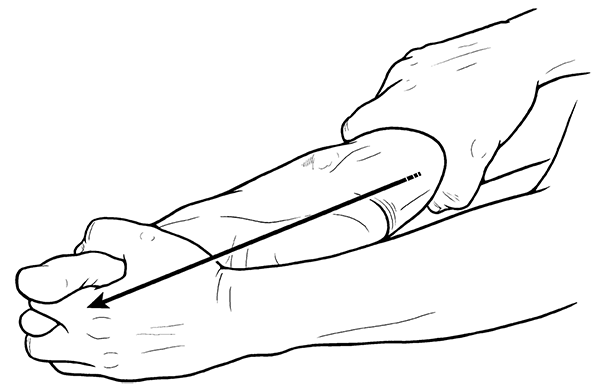 Figure 1.6A (Rotational Foot and Ankle Stretch)
Figure 1.6A (Rotational Foot and Ankle Stretch)
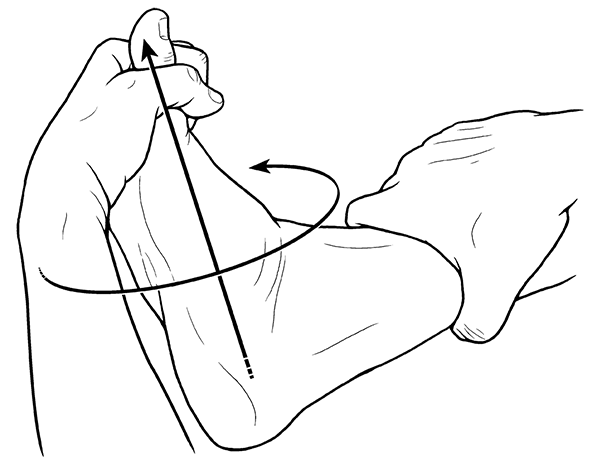 Figure 1.6B (Rotational Foot and Ankle Stretch)
Figure 1.6B (Rotational Foot and Ankle Stretch)
Although your entire foot will move, you'll feel the rotation most strongly in your ankle. You may feel or even hear clicks and pops. As long as there is no pain, that's fine, and even expected if you haven't moved your ankle like this before. If your ankles are typically somewhat painful, feeling that much pain is also okay, you just want to be careful to not make the pain increase beyond that. Over time (many days or weeks of practice), both the pain and the pops and clicks will improve.
Foot, Seated: Series Two
1. Foot Wringing, Upward
Purpose
Physical:
Opens the joint spaces between all the bones of the foot; further opens the ankle; provides a spiraling or shearing stretch though the muscles, tendons, and ligaments of the foot.
Energetic:
By opening the physical spaces in the foot, all of the energetic pathways are freed, allowing for unrestricted qi flow. In addition to deepening the benefits already stated for all the foot exercises, this begins the process of grounding, providing greater stability and a sense of connection with and support from the earth.
Techniques Used
Stretching; joint mobilization. Some acupressure to Kidney 1, the Bubbling Well Point, may occur, but that is not a main focus of this exercise.
Method
Sitting either on the floor or in a chair as in the previous exercises, cross your right leg over your left knee. Interlock your fingers, and place them palm side down across the
top of your right foot. Your right thumb will then be in a position to cross just under the ball of your foot, so that the tip of your thumb rests on or near Kidney 1, Yongquan (the
Bubbling Well Point). Your left thumb should cross over your right, so you are securely grasping your foot. Firmly twist your foot, so that the sole surface faces upward, toward the sky
(
Fig 1.7
on next page
).
Your heel will not move very much, as the bones are denser there and don't allow much movement. That's normal. While maintaining the twist, your right thumb pushes the ball of your foot outward, toward the tip of your big toe. Simultaneously, your left hand pulls the little toe side of your foot toward your heel. This creates the shearing, spiraling aspect of the stretch, and opens your foot and ankle more fully than just a circular stretch would. Here, your outer ankle is stretched more.
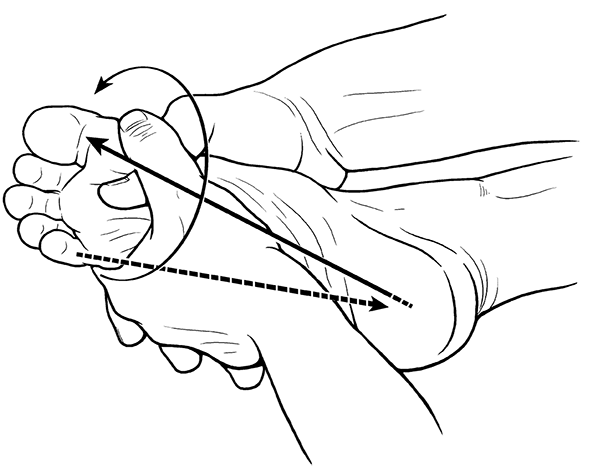 Figure 1.7 (Foot Wringing, Upward)
Figure 1.7 (Foot Wringing, Upward)
Hold this stretch for 20â30 seconds. Repeat once more, or twice if your foot and ankle feel the need. With some practice, you can safely maintain this stretch for two minutes. When performing a two-minute stretch, just do one so that you don't overstretch your ligaments.
2. Foot Wringing, Downward
Purposes and Techniques
These are the same as for Exercise 1.
Method
Seated, with your right leg crossed over your left, keep your fingers interlocked but place them with the palm surface to the sole of your foot. Your left thumb tip will be placed at or near the margin of the web between your big toe and the one next to it. Your hand position will be slightly closer to your toes than in the previous exercise. Firmly twist your foot, so that the sole surface faces downward, toward the ground
(
Fig 1.8
).
Your heel will not move very much, as previously, and your entire foot will normally have less range of motion in this downward direction than in the upward one. While maintaining the twist, your left thumb pushes your big toe outward, toward its tip. Simultaneously, your right hand pulls the little toe side of your foot toward your heel. Here, your inner ankle is stretched more.
Hold this stretch for twenty to thirty seconds. Repeat once more, or twice if your foot and ankle feel the need. In this direction, there is no need to extend the length of the stretch longer, since there is a natural bony limit that prevents further benefit with a longer stretch.